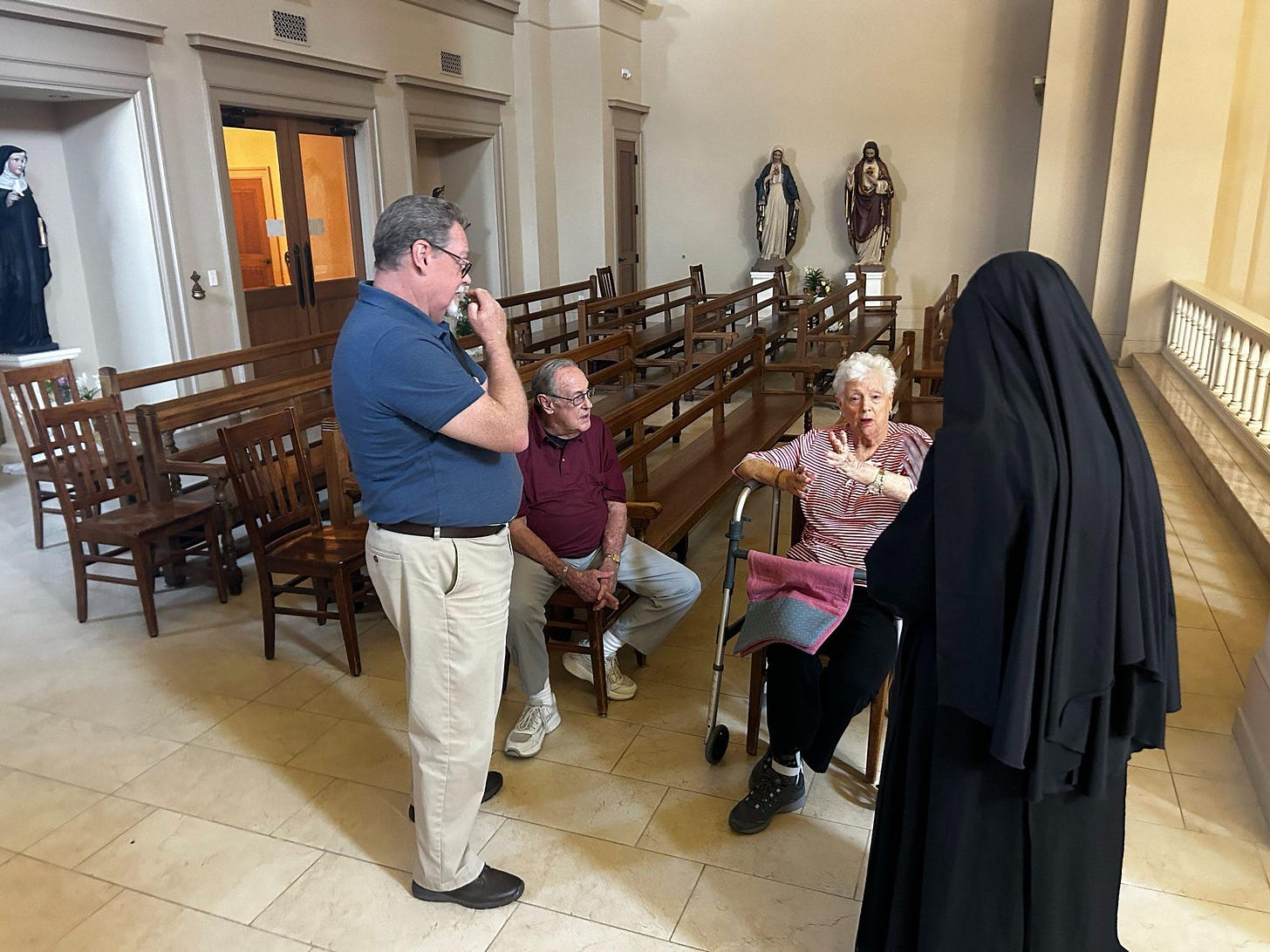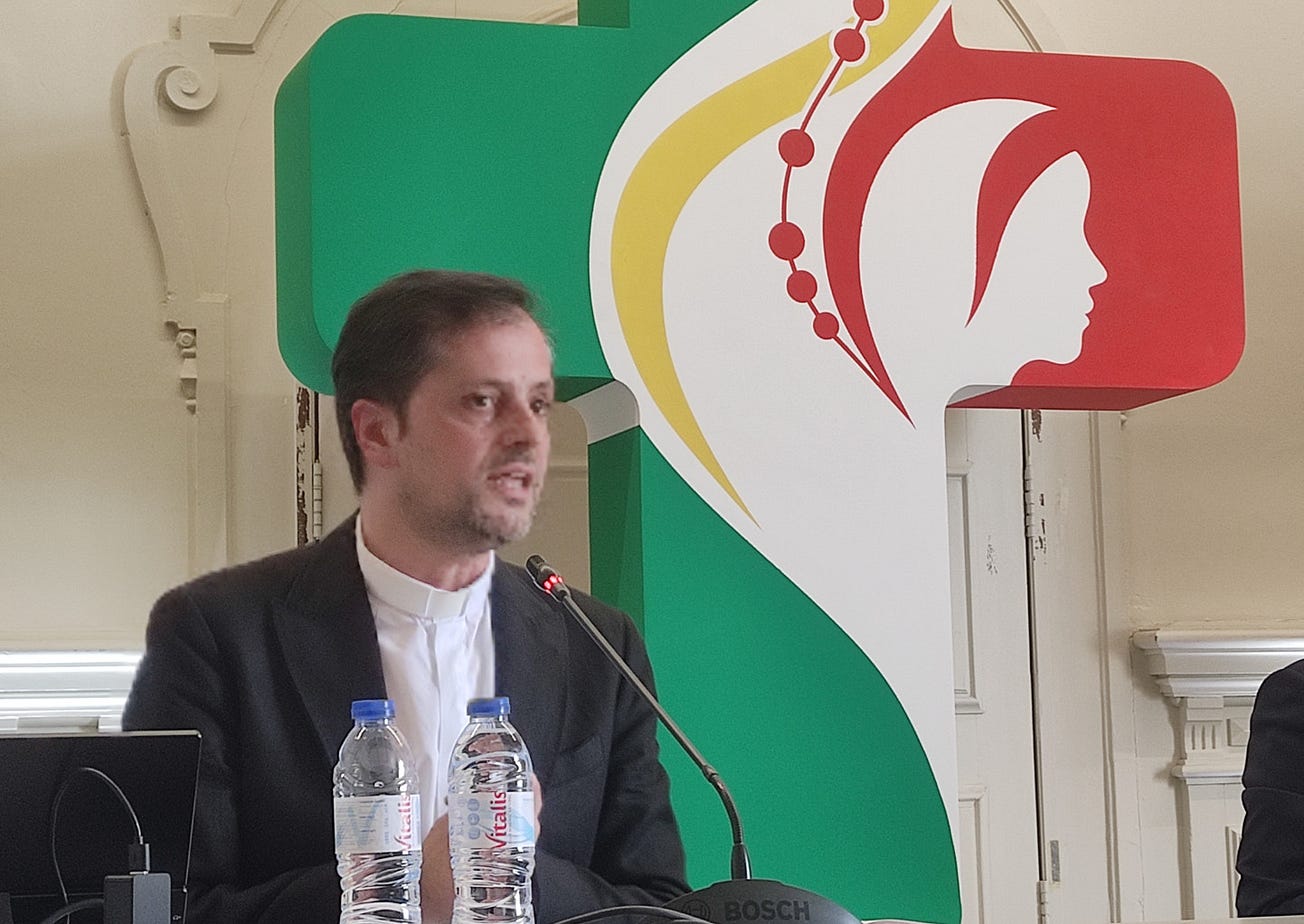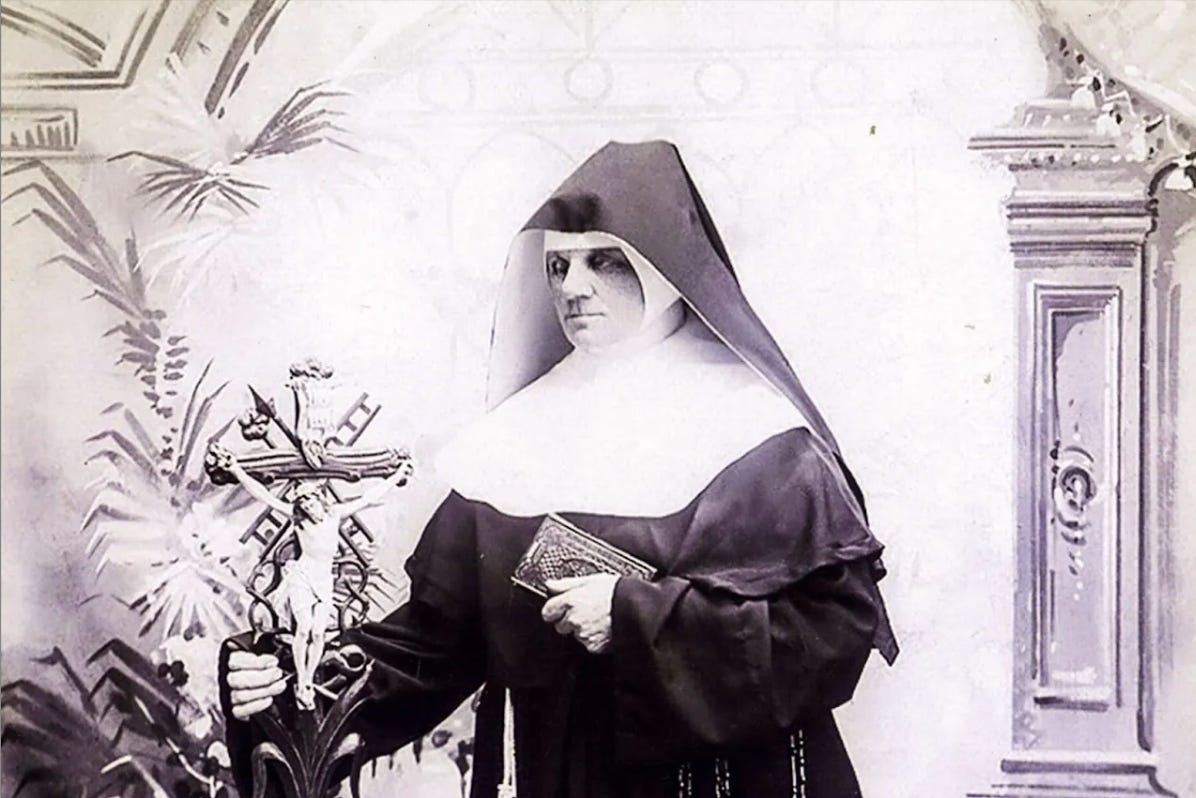The dust has settled, grass is beginning to regrow, and life, once again, has slowed down at the Benedictines of Mary, Queen of the Apostles abbey in Gower, Missouri.
Nuns play with the local children on the monastery’s grounds during a 100th birthday party for the community’s foundress. The convent’s dog runs aimlessly through the trees. The chapel sees a trickle of guests throughout the day.
Looking around Gower Abbey today, it’s hard to believe that just last summer, the grounds of the monastery had struggled to accommodate the thousands of pilgrims flooding to see what they believed might be a miracle - the seemingly incorrupt body of the community’s foundress, Sister Wilhelmina Lancaster.
In 1995, Sr. Wilhelmina established the Benedictines of Mary, Queen of the Apostles, a community that prioritizes a traditional Benedictine lifestyle of prayer and work.
The 50 cloistered sisters farm their land, conduct household chores, and maintain a robust prayer routine that includes the daily celebration of the Traditional Latin Mass.
Sister Wilhelmina died May 29, 2019, leaving behind a vibrant community preparing to open a new abbey in Ava, Missouri.
The community buried their beloved foundress, unembalmed, in a simple wooden casket, clothed in a black habit.
Four years later — last summer — the community decided to move Sr. Wilhelmina’s body to a tomb inside the abbey’s chapel, a long-standing custom for the founders and foundresses of religious communities.
But when the nuns dug up Sr. Wilhelmina’s grave, they found something they weren’t counting on. Instead of a decomposing and rotted corpse, the nuns say they found the body of their founder in good condition, and still covered by a fully intact black habit — even while water had leaked into her casket.
Quickly, the news leaked to the surrounding area, and eventually the media caught on.
Thus began a mad dash of pilgrims hoping to see and reverence the body of a possibly incorrupt nun in America's heartland.
The nuns were overwhelmed by the flood of pilgrims and seemingly unceasing media requests, recalled Sr. Misercordia, who joined the community in 2006.
With pilgrims thronging to their land, the community attempted to maintain a sense of normalcy by continuing to work in the gardens, keeping up with household chores, and maintaining their daily prayer schedule.
Thanks to the help of volunteers who assisted with the needs of visitors, the sisters were mostly able to continue their daily rhythm of prayer and work, Sr. Misercordia said.
“There were certainly a lot more people praying with us in the church and we did assist with some of the hospitality and logistics of the crowds in the initial weeks.”
Joy and holiness
One year later, the long lines and immense crowds have dwindled - although pilgrims continue to pass through the monastery’s iron gates, park on the grass, and pray beside the body of the nun who seized the interest of Catholics across the country.
“It’s just a steady small stream of visitors each day,” Sr. Misercordia said.
The sisters are grateful to return to the quiet life that was envisioned by Sr. Wilhelmina when she founded the community.
“Sr. Wilhelmina wanted us to live a very simple life,” Sr. Misercordia said. “This is why she founded this community with the charism of it being a hidden apostolate of prayer.”
But while life at Gower Abbey has settled down since last summer, the discovery of Sr. Wilhelmina’s body has left some lasting marks on the community.
There is now a sister available to answer the door to the trickle of visitors who still arrive on a daily basis.
And there are more media requests than before - part of a greater awareness about the sisters and their life.
“I think there's just more of an awareness that, oh, there are nuns in Missouri, and obviously, the Lord does hear the prayers of these little sisters, which has led to us receiving a lot more prayer intentions,” said Sr. Martina, a member of the community since 2017.
This increased opportunity to be an intercessor has been a beautiful opportunity for the community to interact with and serve the world outside their convent, Sr. Martina shared with The Pillar.
“It is an example of the Mystical Body of Christ working together because we are to help each other, even if we live in a cloister in rural Missouri.”
And the convent has received more than just an influx in prayer requests - they have also seen an uptick in applications.
“As the community has grown, we just keep getting more applications every year. We are at the point where we're exploring different possibilities for ways of expanding the community because we have so many sisters. But certainly, there's a lot more young women who know about us now,” Sr. Misercordia said.
The women are not just attracted to the convent because of Sr. Wilhelmina, she clarified, but rather because of the life that she modeled and instituted within the convent.
“These women want something heroic,” Sr. Misercordia said. “It is heroic to sacrifice everything because what does everyone else want? They want the world; they want to have a husband. To live here is a sacrifice; it is saying no to the world and all of its pleasures. To give that up is huge, but these women desire the divine husband and are willing to give everything to be with him.”
It’s not just aspiring religious sisters who continue to be attracted to the community in Gower, Missouri.
Abel McNece moved to Gower with his wife and three young children in November. He said that his family was drawn to the community after experiencing the nuns’ life together.
“The joy and the holiness of the sisters are so beautiful. Visitors, as well as those who live here and are part of the community, can't help but notice the radical holiness here,” McNece said. “Everybody remarks that they can’t help but smile when they are here; it is just pure joy.”
Theresa Watts, a mother of eight, agreed.
Watts said she frequently brings her children to Gower - a two-hour drive from her home in Kansas - to show them that a life of holiness is possible.
“There is a holiness around that is good for the children to see. It draws them in, and you just want them to be around this radical holiness. It is a great example for them,” she told The Pillar.
The presence of Sr. Wilhelmina is an added bonus.
“I have been praying to her as an elderly patron for a while now,” Watts said. “The fact that she is incorruptible and has brought so many people together, as so many people have started to pray to her, she is so beautiful.”
“I want my kids to love her and to love the Church, to love the Mass and the nuns, and I want them to learn to be more like her and be better Catholics.”
Reports of miracles
Since the discovery of Sr. Wilhelmina’s body, Mother Cecilia said, the community has been informed of “a great many miracles” attributed privately to her intercession.
“Some situations have been quite dire, even life-threatening, and we have seen complete reversals and many people restored to health. What is more important is the restoration of spiritual health, a turning back to God.”
Last summer, Tom Johnson, now 84, began saying good-bye to family and friends.
He had stage four cancer, and doctors predicted that he had no more than six months to live.
“I was saying goodbye to everybody I knew,” Tom told The Pillar. “I went in thinking this was my last Thanksgiving; this was my last Christmas; this was my last birthday. I started putting all of my files and financial things in order.”
Myra, his 84-year-old wife, struggled with dementia, was confined to a wheelchair, and unable to care for herself, making it difficult for her to understand her husband's ordeal.
Their son, Steve, was losing hope.
But then he heard the story of a small community of nuns discovering the possibly incorrupt body of their foundress, Sr. Wilhelmina, at their convent in rural Missouri.
Wanting to see this phenomenon for himself, he made the trek to Gower, where he saw and touched the apparently incorrupt body of Sr. Wilhelmina.
Steve brought with him a rosary, which he touched to Sr. Wilhelmina’s hand, praying for a miracle.
Then, even though neither of his parents were religious, he gave the rosary to his dad, asking him to pray.
Reluctantly, Tom agreed, and he began carrying the rosary wherever he went, praying throughout the day for his wife’s health.
Then, in January, Tom had another scan. The results were shocking, Steve said. The cancerous tumors had nearly disappeared.
Equally shocking, Myra had regained both her memory and mobility, Steve said.
“I was praying for so long for my parents to be healed,” Steve shared with The Pillar. “It's incredible to see the healing power of God through prayer and through touching the rosary to Sr. Wilhelmina and praying for her intercession. I mean, that's significant and powerful.”
After waiting a year, Tom and Myra finally had an opportunity to visit Gower, Missouri, and pray by the body of Sr. Wilhelmina, offering thanks for her intercession.
On April 13 of this year, the couple traveled to Gower. Upon their arrival, they were surprised to discover that it was Sr. Wilhelmina’s 100th birthday.
The couple laid flowers on the altar covering Sr. Wilhelmina’s body. They met with the religious sisters, and took time to pray and reflect.
“Being here felt overwhelming,” Tom said. “Being able to bring flowers, pray right by her, and come out here for her birthday on top of it. It was to me very spiritual and very overwhelming in a beautiful way.”
“We both feel that Sr. Wilhelmina played a very big part in getting us back on the roadway and interceding for us,” he said.

A future saint?
While some of the pilgrims who have come to pray before Sr. Wilhelmina’s body are convinced of her sanctity, the process of declaring someone a saint is a lengthy one - and in the case of the abbey foundress, that process has not even begun.
Although it is piously believed that God preserves the bodies of some saints from the normal decomposition process because of their sanctity, the Church doesn’t actually consider an incorrupt body to be an indication of sainthood.
The Church generally requires a five-year waiting period after an individual’s death before a petition for canonization can be filed. The five-year anniversary of Sr. Wilhelmina’s death will be on May 29 this year.
After that, the process includes a thorough investigation of the person’s life and writings, requiring the involvement of both the local bishop and the Vatican.
The person must also have two miracles attributed to their intercession and confirmed by the Vatican before being canonized a saint.
“It is a very long, tedious, and expensive process to pursue canonization. Most of the costs come from the hiring of individuals and officers for their services in the procedure,” Mother Cecilia told The Pillar.
“We have not heard anything from the Vatican specifically about Sister Wilhelmina's cause for canonization; nevertheless, we have spoken at length to a representative who works for the Dicastery for the Cause of Saints,” she said.
“The diocese [of Kansas City-St. Joseph] has been supportive of us and seems to be quite welcoming of the prospect of pursuing the process of canonization when the time comes,” she added.
A spokesperson for the Diocese of Kansas City, St. Joseph, told The Pillar that right now, the diocese has a limited role in the canonization process and referred all questions to the prioress.
The sisters at Gower Abbey are documenting the alleged miracles reported to them in connection with Sr. Wilhelmina. If her canonization cause is ever opened, those reports will need to be investigated and authenticated.
Still, the sisters do not think Sr. Wilhelmina will be officially recognized as a saint any time soon.
They nuns say they are ok with that. They are content to work and to pray in the community she founded.
And they say they still feel spiritually close to her.
“Sister Wilhelmina was the rock of the community, and to discover her incorruptible led to a resurgence of appreciation of prayer, especially as she emphasized it, in the rosary and the liturgy that we are bound to sing every day,” Mother Cecilia shared. “The liturgy was of utmost importance to Sister Wilhelmina, so her story has revitalized our prayer life in many ways.”
Meanwhile, the visitors who continue to trickle in to the monastery grounds, down the gravel roads and past the cow pastures, say they are grateful to encounter the presence of God in the middle of rural Missouri.
“We came out here to experience Sr. Wilhelmina, but what we realized through her story and her example is the power of prayer,” Tom Johnson said.
He said he has not only experienced a physical healing, but a restoration of faith as well.
“Throughout my cancer, I had gotten further away and lost faith in God,” he acknowledged. “But now, Sr. Wilhelmina has helped me to embrace God. She has been the bridge to help me build a better relationship with God.”







